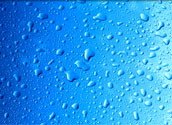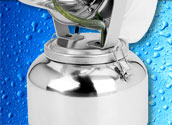 |
 |
 |
 |
 |
 |
 |
 |
A fog is a suspension of small liquid droplets in gas (generally air) characterized by its droplet size distribution. This can vary greatly, but most people describe fogs in qualitative terms without worrying about droplet diameters and such. There's no generally accepted match-up of these qualitative, descriptive terms and droplet sizes, but an approximate correspondance might be: dry fog (5-15 micron Volumetric Mean Diameter); wet fog (20-30 micron VMD); mist (30-60 micron): fine spray (above 60 micron), etc. The visibility of a fog depends on the ability of the droplets to scatter or reflect light. Just as with droplet size, visibility varies widely. As you would expect, larger droplets are easier to see. Small droplets, particularly in the ULV (ultra low volume) range under 15 microns are practically invisible without special lighting. Fog stability varies widely as well. Important factors are: droplet size; the relative humidity; liquid volatility, surface tension and density; air currents; particle size distribution; temperature; and condensation surfaces. Fortunately, you don't have to predict fog behavior. Just thinking about your application will usually suggest what type of fog would be best (and sometimes even what equipment to use). On the other hand, a “wet” fog of larger droplets is better when trying to settle dust or asbestos particles, and when applying certain cleaning, disinfection or mold control chemicals that require that the surface be wetted. In such work, fogging may offer significant advantages over traditional "bucket and mop" procedures: faster application, more uniform coverage, and speedy dry time. The user may have to experiment to find the optimum droplet size. A humidification user must balance the advantages of a higher flow rate (shorter run time but larger droplets) against the possible disadvantages (poor distribution, droplet fallout, undesirable wetting). It often helps to experiment first, applying water only (no chemical) to see what flow rate works best in your situation. [If you plan to use an oil-based chemical, substitute kerosene for water.]
|
There are three common fog generation techniques (a fourth combines two of these): Thermal Foggers evaporate an oil-based liquid such as light kerosene on a hot surface. Upon exiting the nozzle, oil vapors condense into droplets to create a fine fog. Thermal foggers cannot dispense water-based products and are generally limited to outdoor use. High Pressure Spray Nozzles can deliver a wide range of particle sizes, depending on liquid pressure and nozzle opening. For fog output, typical liquid pressures are 500 - 1,500 psi, and orifices 0.005 inch or smaller. Spray nozzles can handle both oil- and water-based liquids but require high grade filtration to protect against nozzle plugging. Also, they are susceptible to nozzle erosion over time, and larger sized droplets. Mechanical ("cold") Foggers use turbulence in the fogging nozzle to shear liquid into small droplets. The typical air source is a high velocity fan, usually integrated with the fogging nozzle. There is no need for liquid pressure. In most cases, the atomization nozzle doesn't have any small orifices, so nozzle plugging is not a problem. The cold fogger has one other advantage – by adjusting the liquid flow rate, the user can change the droplet size of the discharge. At a low flow rate, the liquid spends more time in the atomizing section of the nozzle and is chopped into smaller droplets. Exit noise – the "whoosh" of air coming from the nozzle is similar to that of a vacuum cleaner – may disqualify the cold fogger in applications favoring a noiseless discharge. The Air Atomizing Nozzle is a hybrid of the spray nozzle and the mechanical fogger. Liquid is first broken into coarse droplets with a low pressure nozzle, then further atomized by being hit with a blast of compressed air. This design therefore needs both pressurized liquid (pump or pressurized container) and pressurized air. Using a larger liquid orifice can make it less susceptible to plugging than the high pressure nozzle, but it tends to produce larger droplets. Also, the air source must be oil-free to prevent a build-up of dirt in the nozzle. A fifth atomization technology, ultrasonic, is nearly silent in operation and often used in small bedroom humidifiers. However, its limited capacity and high maintenance requirements make it poorly suited to industrial applications.
Fogmaster began life as a division of the AFA Corporation, a pioneer in fogger and trigger sprayer technology, in the 1960's. Fogmaster Corporation was formed in 1982 when AFA spun off its "cold" fogging manufacturing operations as a separate business. It expanded into its current Deerfield Beach facilities in 1986.
|
| Home | About Us | Products | Applications | FAQ | Support | Contact Us |